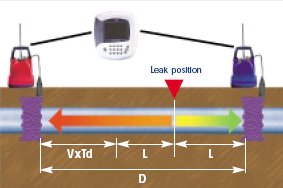Emergency & Scheduled leak pinpointing

Experienced ATS Field Technicians are available 24 hours a day / 365 days a year to detect and pinpoint leaks.
Since 1979, ATS has maintained a 96% accuracy rate for pinpointing leaks within the first repair excavation. This is the highest documented accuracy in the business.
- Fire Protection water main leaks
- Domestic hot & cold water leaks under slabs
- New water main pressure test leaks
- Baseboard hot water heating
- Municipal water main leaks
- Pools, spas & water feature pipelines
- Hot & chilled water pipelines
No matter when you need us, we'll be on the road to your site quickly.
ATS has provided our valuable services in 20 states all across the USA.
Comprehensive Leak Surveys
Whether you have only 5 miles or over 500 miles of water main, ATS has a leak survey program that can be custom tailored to your leakage severity and budget requirements.
Surveys are conducted during daylight hours with the water system in its normal operating condition. There is no need to tie up your crews assisting us.
 During the detection phase, we can survey 30,000 to 60,000 lineal feet of pipe in a day. Detected leaks of all sizes and types are then accurately pinpointed, marked in the field and documented.
During the detection phase, we can survey 30,000 to 60,000 lineal feet of pipe in a day. Detected leaks of all sizes and types are then accurately pinpointed, marked in the field and documented.
Leaks can also be classified by range of size and type so that you can efficiently prioritize and plan your repairs.
Let the Pros at ATS enable you to take a Proactive approach instead of a Reactive approach to reducing your unaccounted for water loss.
ATS can help you make Water System Management by Crisis a thing of the past.
Depending on the environmental conditions, accuracy of leak pinpointing can be to within inches.
Principle of Correlation

In the "classic" correlation process, two sensors are deployed on pipe fittings ("dry" connection) or connected to hydrants ("wet" connection). The sensors are positioned on each side of the suspected leak position.
Noise is created by the leak as it escapes from the pipe under pressure. This noise is conducted in both directions away from the leak through the pipe wall (as minute vibrations) and through the water column (as a pressure wave).
The leak noise travels at a constant velocity (V), which depends on the material and diameter of the pipe, and arrives first at the sensor nearer the leak. The arrival time at each sensor is registered. The difference (Td) between the two arrival times, combined with knowledge of the pipe type and length, enables the leak position to be calculated by the correlator.
Depending on the environmental conditions, accuracy of leak pinpointing can be to within inches.
